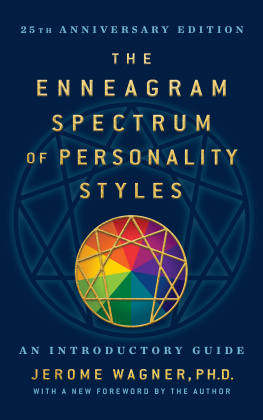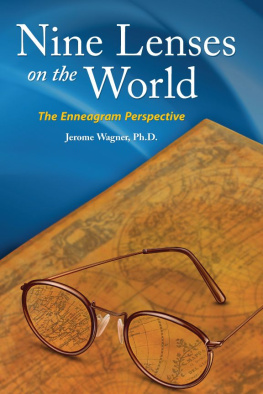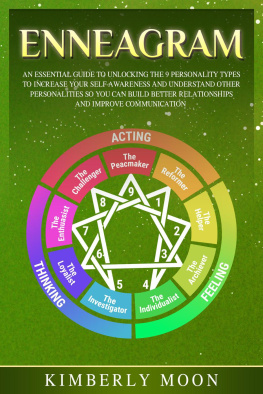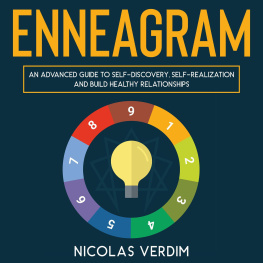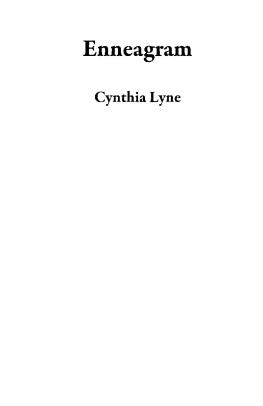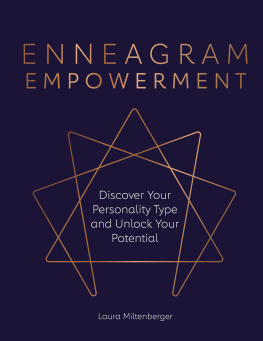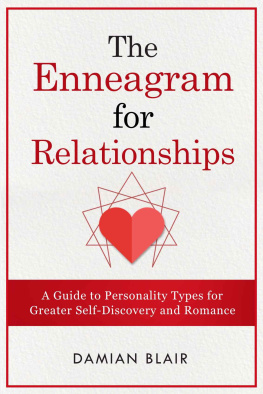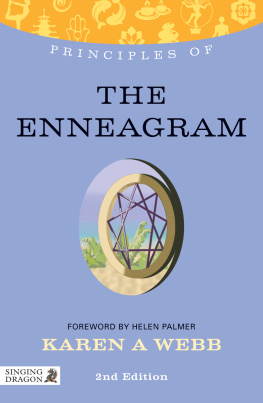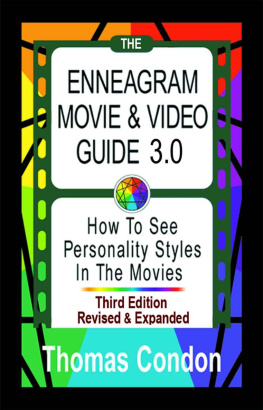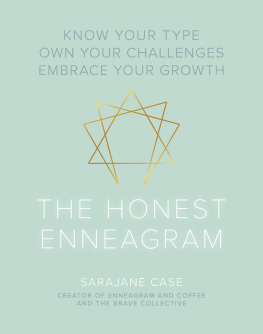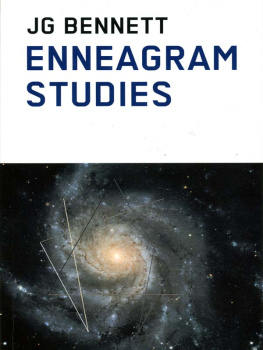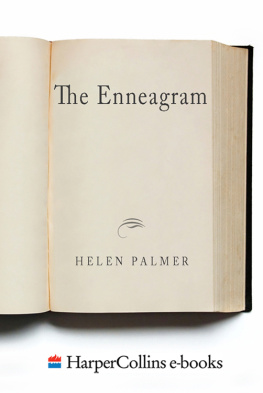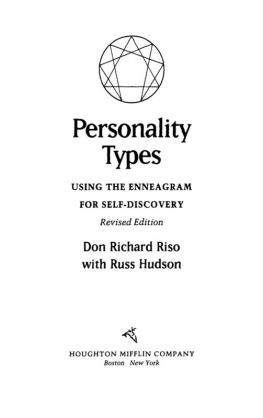Contents
Page List
Guide
THE ENNEAGRAM SPECTRUM OF PERSONALITY STYLES
25TH ANNIVERSARY EDITION
THE ENNEAGRAM SPECTRUM OF PERSONALITY STYLES
AN INTRODUCTORY GUIDE
JEROME P. WAGNER, PH.D.
WITH A NEW INTRODUCTION BY THE AUTHOR
Published 2021 by Gildan Media LLC
aka G&D Media
www.GandDmedia.com
THE ENNEAGRAM SPECTRUM OF PERSONALITY STYLES. Copyright 2021 by Jerome P. Wagner, Ph.D. All rights reserved.
No part of this book may be used, reproduced, or transmitted in any manner whatsoever, by any means (electronic, photocopying, recording, or otherwise), without the prior written permission of the author, except in the case of brief quotations embodied in critical articles and reviews. No liability is assumed with respect to the use of the information contained within. Although every precaution has been taken, the author and publisher assume no liability for errors or omissions. Neither is any liability assumed for damages resulting from the use of the information contained herein.
First edition published 1996, second edition published 2021.
Cover design by Tom McKeveny
Design by Meghan Day Healey of Story Horse, LLC
Library of Congress Cataloging-in-Publication Data is available upon request
eISBN: 978-1-7225-2620-7
10987654321
Contents
by Helen Palmer
by Thomas Condon
Style 1
The Good Person
Style 2
The Loving Person
Style 3
The Effective Person
Style 4
The Original Person
Style 5
The Wise Person
Style 6
The Loyal Person
Style 7
The Joyful Person
Style 8
The Powerful Person
Style 9
The Peaceful Person
Foreword
by Helen Palmer
I first met Dr. Wagner through a microfilm of his dissertation over twenty years agoan academic treatment of the Enneagram material that has recently attracted a wide international audience. Since then, weve conferred, argued, agreed, and challenged each others thinking, all of which has been immensely satisfying. Even when you dont see eye to eye with Jerry, his clarity always adds an interesting angle to the debate.
This workbook is his piece of the Enneagram magic that draws those who seek something more than Freuds agenda of good love and work as the apex of well-being. Its a really good guide and Im delighted to recommend it to both new and longterm students who will benefit from his way of bringing the types to life.
Helen Palmer
Teacher and author of The Enneagram, The Enneagram In Love And Work, The Pocket Enneagram
Foreword
by Thomas Condon
M ost introductions to the Enneagram reduce it to a collection of types, but this book takes just the right tone. It offers a dynamic version of the system that is rooted in common sense and personal experience.
The writing is distilled and precise, and Wagners descriptions of personality styles reflect his own vocabulary and vision. Deep mastery of the Enneagram is hard-won and evident in the quality of insight presented here; the author has decades of experience and it shows.
I especially like the books exercises. Simple yet profound, they point directly to the Enneagrams best purposeunveiling our inner map of reality. Readers will find surprising new ways to apply the Enneagram both personally and professionally as well as a direct path to their personal depths. For these and many other reasons, this book is a pleasure to recommend.
Thomas Condon
Author of The Everyday Enneagram, The Enneagram Movie & Video Guide
Introduction to the 25th Anniversary Edition
I ts hard to believe its been twenty-five years since The Enneagram Spectrum of Personality Styles was first published. Much has changed since then, as looking at my old photo in the back of the original would attest. Just as the number of hairs on my head have diminished, so have the number of Enneagram books, articles, websites, inventories, and products increased.
The bibliography originally listed twenty-one books, seven articles, and eight dissertations. I will leave it to the reader to add up the number of entries in the new bibliography. And even this is incomplete.
I wrote my dissertation on the Enneagram in 1981. It was the first unpublished (as most dissertations are) description of the Enneagram system and styles. I was named an Honorary Founder of the International Enneagram Association in recognition of this contribution. As I said when I received the award, if you join something early enough and stay around long enough, you get a prize. I am honored in both meanings of the word.
When I researched my dissertation forty years ago, it was the third dissertation on the Enneagram and nothing was published outside of academia. The Enneagram was passed on through oral tradition and teaching. This led me to suggest to my dissertation committee that, instead of bibliographical citations, I put in phone numbers in the reference section so they could call up people and hear what they had to say about the Enneagram. Surprisingly they failed to see the humor in this but nonetheless let me proceed with my research. I am forever grateful to their farsightedness which allowed me to get out of graduate school.
When I first learned the Enneagram in 1971, we were cautioned to not speak about it until we were thoroughly familiar with the styles. That lasted about a week as it was very difficult to keep quiet about such a fascinating system. Since then much has been spoken and written about the Enneagram.
What is one to make of all this new material on the Enneagram? Was the Enneagram written in stone and so should be transmitted exactly as learned? This is the oral tradition approach where the student learned and memorized the material from the master and passed it on unaltered
Or is the Enneagram a living tradition that grows and diversifies and is open to ever new contributions and adumbrations? Is the Enneagram best optically viewed through a microscope or telescope where the vision is held steady? Or is it best optimally viewed like a kaleidoscope where new configurations appear with each turn?
And if there are new interpretations and refiguring being offered (which might be required to get your book published), how is one to evaluate the additions and accretions. If all theories are false or partial or not yet replaced, how does the listener/reader assess them?
Well, there are several validity sources.
One might appeal to authority. This is the dogmatic approach. Who said so?
One might appeal to reason. This is the rational approach. Does this make any sense? Is it logical?
One might appeal to experience. This is the romantic approach. Does this fit with my experience?
One might appeal to science. This is the empirical approach. Show me the data.
One might appeal to usefulness. This is the pragmatic approach. So what? Can I apply it?
One might appeal to revelation. This is the faith approach. What does God or some higher authority have to say about it?
One might appeal to scripture. This is the hermeneutic approach. Where is it written?

